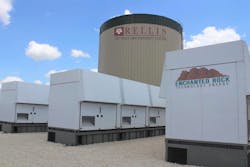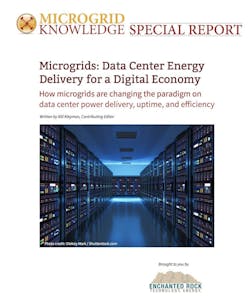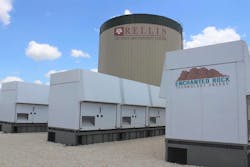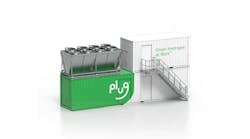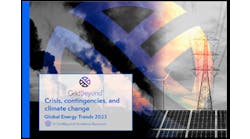This special report series focuses on data center microgrids for the colocation and big data industry. The entry below explores the evolution of data center microgrids and how they can increase efficiency and resiliency.
Get the full report.
Smart is the new normal as we enter and expand in a digital era. Driven by data, autonomous systems, and more demand around the data center and edge solutions, leaders in the space need smarter options to help them go from reactive to predictive and prescriptive.
Modern microgrids are more intelligent than ever before
Advanced microgrids are smart – they have sophisticated software and controls. Among other things, this intelligence allows them to island from the primary grid. That means when they see trouble on the primary grid beginning to occur, microgrids can separate and protect themselves. They stop relying on the grid’s power plants and instead rely only on their own. But they can also work intelligently in unison.
Advanced microgrid controllers leverage machine learning and data-driven solutions to track real-time changes in the power prices on the central grid.
When everything is working right, the grid and the microgrid operate in tandem and serve one another. For example, on blue sky days, the main grid is used for supply. But if the main grid experiences an outage or runs low on power supply — as it sometimes does on hot summer afternoons when we all are running our air conditioning—it can turn to the microgrid for help. The grid can be a source of revenue for microgrids that provide services known variously as capacity, emergency reserves, resource adequacy, demand response, and ancillary services.
Furthermore, modern microgrids are data and software-driven. Advanced microgrid controllers leverage machine learning and data-driven solutions to track real-time changes in the power prices on the central grid. If energy prices are low at any point, a solar and storage microgrid may choose to buy power from the primary grid to charge its battery systems. Then, as grid power becomes pricey later in the day, the microgrid may sell services to the grid or discharge its batteries rather than use grid power.
Because microgrids are intelligent, software-driven solutions, the data they produce can be leveraged to influence end-user power decisions. Additionally, microgrid providers can capture this data to ensure that the microgrids are operating optimally. They can use predictive analytics around the information that’s being gathered to forecast issues, power requirements and maintenance cycles. In some service models, you never have to touch the microgrid once it goes in. Governed by software and smarter microgrid controller systems, today’s microgrids work together via complex algorithms, data-driven solutions, and advanced analytics to ensure that the microgrid’s resources are consistently and adequately used. These software-driven tools deliver system performance to a level of efficiency that is difficult to achieve alone. The orchestration of this microgrid ecosystem is managed in a near instantaneous fashion—autonomously. There is no need for human intervention.
Unlike many traditional backup generators, microgrids can support continuous operations and provide grid reserve capacity. Either way, microgrids can be available to operate 24/7/365, managing and supplying energy to their customers.
Microgrids and next-generation generators can get along nicely
When it comes to greener and cleaner power, many leading organizations have actively committed to reducing emissions and running more optimally. However, working with traditional legacy backup generators can pose some environmental efficiency challenges. As it relates to environmental performance, most data center operators are in a class by themselves. Their focus on improved energy efficiency inside the data center has achieved tremendous improvement in the last decade, and the decarbonizing of energy supplies is unsurpassed by any other industry.
However, the diesel generator fleets at most data centers run counter to these achievements. Although some new, modern Tier-4 generators use low sulfur diesel and additional pollution controls, they are not emission-free. Diesel fuel is higher carbon-emitting, higher particulate emitting, and higher VOC and NOx emitting when compared to natural gas.
Microgrid providers use predictive analytics around the information that’s being gathered to forecast issues, power requirements and maintenance cycles. In some service models, you never have to touch the microgrid once it goes in.
Natural gas is becoming an increasingly popular fuel choice for microgrids due to its robust fuel delivery network and lower environmental impacts. According to a paper by the National Renewable Energy Laboratory, natural gas has a more reliable fuel supply compared to diesel, and it is able to efficiently combat long-duration outages without interruption. These generators can perform like a diesel, with fast ramp times, transient performance, and a compact footprint, but are cleaner and quieter than even Tier 4 generators.
Microgrids can also combine a variety of energy sources to met environmental goals as well as resiliency needs. Photo: Enchanted Rock
Microgrids can also combine a variety of energy sources to met environmental goals as well as resiliency needs. For example, solar and storage microgrids utilize renewables to provide environmentally conscious power, but they are limited in the number of hours they can provide backup capacity. By adding a natural gas generating element to the mix, customers receive long-duration backup power for extended utility outages that last days or even weeks.
With that in mind, there is sometimes the notion that fossil fuels are always dirty. The good news is that there are cleaner options with some new, modern solutions. Additionally, these microgrids can be made even cleaner with options like renewable natural gas or Neste renewable diesel, which was used by a microgrid in San Francisco, Calif., during Super Bowl L. Although cleaner, these solutions may be more expensive to operate and maintain.
Another critical point when it comes to working with diesel generators is the ability to test your backup solution and microgrid. In some states, testing backup generators that run on diesel is limited. If you are a hyperscale data center with many microgrids running on diesel, you might run into some testing and validation issues. So, during the planning process, be sure to understand your requirements and work with the right solution that will not put you at risk.
Catch up on the first, second, and third entry in the report series that explores data center microgrids.
And also stay tuned. In the coming two weeks this Microgrid Special Report series will finish with the following article:
- Microgrid Partners Aim to Change Power Delivery, Efficiency and Economics
Download the full Microgrid Knowledge report, “How Microgrids are Changing the Paradigm on Data Center Power Delivery, Uptime, and Efficiency,” free of charge courtesy of Enchanted Rock. Or listen to the discussion “Microgrid Myths: Busted,” a free webinar on data center microgrids.
